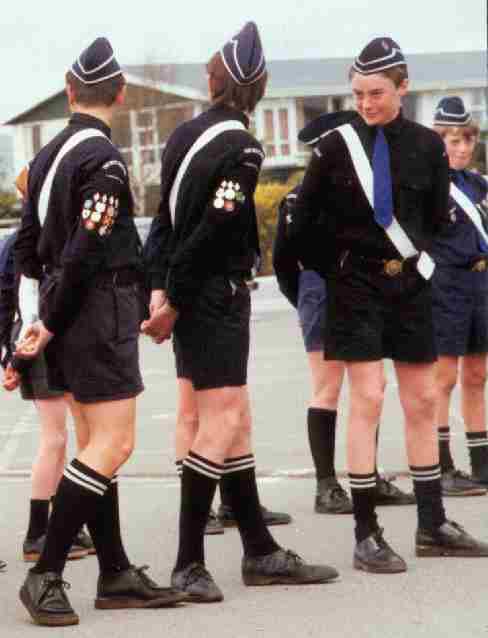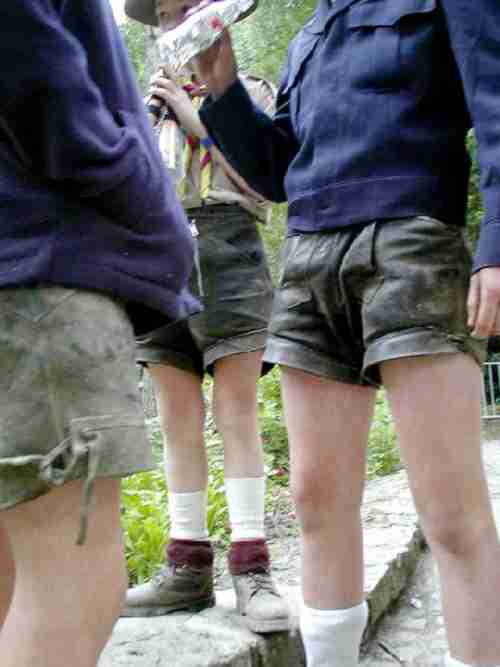
Figure 1.--The Boys' Brigade eventually followed the Scouts in adopting short pants uniforms.


Figure 1.--The Boys' Brigade eventually followed the Scouts in adopting short pants uniforms. |
Short pants had been worn by boys in the late 19th century, but they were not widely worn and were mostly worn by younger boys. Note that short pants differeed from kneepants, which were widely worn, in that they did not have three buttons at the knee hem and were worn with kneesocks and not long stockings. The original shorts, however, were mot much shorter than kneepants. Baden Powell ose to introduce short pants to Scouting as a practical comfortable garment, much more suited to active outdoor activities than the long stockings and kneepants more common at the time. Boys took to them immediately, in part because they had a macho, military image about them. Short pants were used by the British Army in tropical postings and for some units duing the Bohr War. Virtually every subsequent youth group proceeded to adopt short pants for the uniform. This was in part a reflection of how these groups used the Scouts as a model. It was also in part due to the fact that most European boys as well as boys in other countries mostly wore short pants.
Short pants had been worn by boys in the late 19th century, but they were not widely worn and were mostly worn by younger boys. The greatest prominence of short pants occurred, however when they were adoted by the British ASrmy for use in tropical postings. I'm not sure when this ocurred, but it was probably about 1990 as the tradutin was well established by the turn of the 20th century. Of course it was naturak for Lord Baden Powell, with his Army background, to adopt the style for the Scout uniform when he founded the organizatio in 1906.
The earliest short pants wore by Baden Powell's Scouts differeed little from kneepants. The original shorts were mot much shorter than kneepants. Early short pants were worn quite long, generaly to the top of the knee. The principal differences weith kneepants is that they were not worn below the knee and they did not have the three ornamental buttons at the knee hem.
One major improvement as far as most early Scouts were concerned was that short pants were worn with kneesocks rather than long stockings. Knee socks wre much less cumbersome than long stockings. They did not require stcking supporters and were alltogetgher easier to deal with, especially on camping expeditions.
Baden Powell chose to introduce short pants to Scouting as a practical comfortable garment, much more suited to active outdoor activities than the long stockings and kneepants more common at the time.
Boys in uniformed youth groups have worn a variety of styles of short pants. The major stylistic variation has been the length of the shorts.
The major stylistic variation in youth uniform shorts has been the length of the shorts. Boys in the early years of Scouting wore very long shorts, especially in the 1910s and 20s. Boys in the 1910s often wore shorts only slightly longer than kneepants. Boys began wearing shorter shorts in the 1930s. Hitler Youth boys in particular wore much shorter shorts than was common in Scouting. Agter World War II (1939-45) some Scout groups adopted shorter shorts. Many Cubs and Scouts in the in the 1970s and 1980s wore short cut shorts. The Flemish VNJ also wore short cut shorts. Scouts in the 1990s began wearing longer and baggier shorts.
Pockets on the shorts wprn as part of youth uniforms were fairly standard. The new American Scout uniform intoduced in 1981 included new cargo pockets which have been adopted in some other countries.
Scout groups normally adopted short pants with belt loops rather than elastic waists.

Figure 2.--It is not only German youth groups that wear lederhosen. This is a French group.. |
Lederhosen were widely worn by Hitler Youth groups. After World War II, Boy Scouts in Autria, France, and Germany often wore lederhosen. We thought this was also the case in Switzerland, but a Swiss reader tells us that this was not the case. Lederhosen were, however, often worn in the Flemish VNJ. For the most part they were worn by individual boys whon substituted them for the regulation uniform short pants of their organization. Lederhosen seem particular suitable for hiking and camping because of their durability and minimal care necessary to maintain them. Some organiations like the French St. George's Scouts adoopted them as part of the official uniform.
HBU has little information on the material uniform shorts were made of. I think that the orginal Scout shorts were flannel. One popular early fabric was corduroy. The German Wandervogel boys wore corduroy shorts. They were also popular with French Scouts. I'm not sure what the black shorts worn by the Hitler Youth were made of.
British boys took to them immediately, in part because they had a macho, military image about them. Short pants were used by the British Army in tropical postings and for some units duing the Bohr War.
The short pants uniform proved popular all over Europe. In contrast, American boys did not much like the British import and insisted on wearing knickers rather than shorts. I'm not sure why American boys reated to short pants differebntly than boys in other countries. Perhaps the Anmerican Army's failure to adopt a short pants uniforms for tropical postings was a factor.

Figure 2.--The Belgian VJR is one European youth group that continued to wear a short pants uniform. Here the VNJ boys and girls are working on a May pole. |
Virtually every subsequent youth group proceeded to adopt short pants for the uniform. This was in part a reflection of how these groups used the Scouts as a model. It was also in part due to the fact that most European boys as well as boys in other countries mostly wore short pants.
No boys' organization is so associated with short pants than the Boy Scouts around the world. Short pants were made part of the English Scout uniform when the organization was first formed in 1908. Virtually every country around the world followed the English example, except America where boys mostly wore knickers. Scouts around the world continued wearing mostly short pants until the Enhlish Scout movement adopted a long pants uniform in 1969. Many other Scout mobvements in the following years followed suit. Interestinglu, iy was at this time thast more and more American Scouts begasn wearing the short pants uniform for summer asctivities.
I am less sure about uniform trends in the Boys' Brigade than the Scouts. I have seen Boys' brigade units wearing both short and long pants in the early 20th century. Shorts were more common in the 1930s and 40s, but long pants bevame increasingly common after the Ennglish Scouts adopted a long pants uniform--ecept for Australia and New Zealand where shorts pants were still worn in the 1990s.
Hitler Youth boys are well known for black short pants and white kneesocks. This was their dress uniform. Often Hitler Youth boys wore other colored shorts or lefderhosen. This was their summer uniform. The boys wore a long pants inifiorm during the winter.
Most all nationalist groups before and during World War II wore short pants uniforms. Some grouos had winter long pantsuniforms. These groups ddeclined in popularity after the War. One group which has proven popular is the Flemish VNJ which in the 1990s continued to swear a dhort pants uniform.
Navigate the Historic Boys' Uniform Web Site:
[Return to the Main pants garment page]
[Introduction]
[Activities]
[Biographies]
[Chronologies]
[Garments]
[Organizations]
[Other]
[Bibliographies]
[Contributions]
[FAQs]
[Boys' Uniform Home]
Navigate the Historic Boys' Uniform Web chronological pages:
[1900s]
[1910s]
[1920s]
[1930s]
[1940s]
[1950s]
[1960s]
[1970s]
[1980s]
[1990s]
[2000s]
